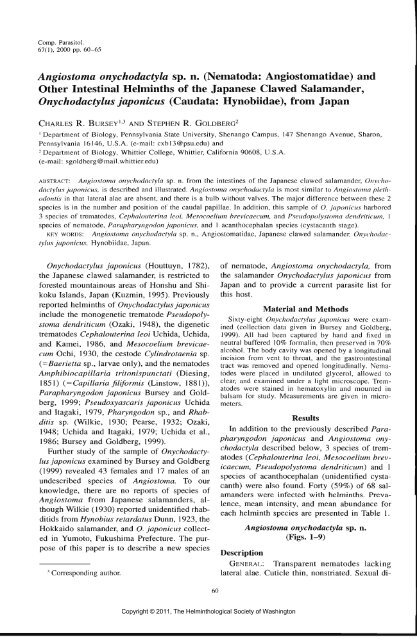Comparative Parasitology 67(1) 2000 - Peru State College
Comparative Parasitology 67(1) 2000 - Peru State College
Comparative Parasitology 67(1) 2000 - Peru State College
You also want an ePaper? Increase the reach of your titles
YUMPU automatically turns print PDFs into web optimized ePapers that Google loves.
Comp. Parasitol.<br />
<strong>67</strong>(1), <strong>2000</strong> pp. 60-65<br />
Angiostoma onychodactyla sp. n. (Nematoda: Angiostoniatidae) and<br />
Other Intestinal Helminths of the Japanese Clawed Salamander,<br />
Onychodactylus japonicus (Caudata: Hynobiidae), from Japan<br />
CHARLES R. BURSEY u AND STEPHEN R. GOLDBERG2<br />
1 Department of Biology, Pennsylvania <strong>State</strong> University, Shenango Campus, 147 Shenango Avenue, Sharon,<br />
Pennsylvania 16146, U.S.A. (e-mail: cxbl3@psu.edu) and<br />
2 Department of Biology, Whittier <strong>College</strong>, Whittier, California 90608, U.S.A.<br />
(e-mail: sgoldberg@mail.whittier.edu)<br />
ABSTRACT: Angiostoma onychodactyla sp. n. from the intestines of the Japanese clawed salamander, Onychodactylus<br />
japonicus, is described and illustrated. Angiostoma onychodactyla is most similar to Angiostoma plethodontis<br />
in that lateral alae are absent, and there is a bulb without valves. The major difference between these 2<br />
species is in the number and position of the caudal papillae. In addition, this sample of O. japonicus harbored<br />
3 species of trematodes, Cephalouterina leoi, Mesocoelium brevicaecum, and Pseudopolystoma dendriticiun, 1<br />
species of nematode, Parapharyngodon japonicus, and 1 acanthocephalan species (cystacanth stage).<br />
KEY WORDS: Angiostoma onychodactyla sp. n., Angiostoniatidae, Japanese clawed salamander, Onychodactylus<br />
japonicus, Hynobiidae, Japan.<br />
Onychodactylus japonicus (Houttuyn, 1782),<br />
the Japanese clawed salamander, is restricted to<br />
forested mountainous areas of Honshu and Shikoku<br />
Islands, Japan (Kuzmin, 1995). Previously<br />
reported helminths of Onychodactylus japonicus<br />
include the monogenetic trematode Pseudopolystoma<br />
dendriticum (Ozaki, 1948), the digenetic<br />
trematodes Cephalouterina leoi Uchida, Uchida,<br />
and Kamei, 1986, and Mesocoelium brevicaecum<br />
Ochi, 1930, the cestode Cylindrotaenia sp.<br />
(=Baerietta sp., larvae only), and the nematodes<br />
Amphibiocapillaria tritonispunctati (Diesing,<br />
1851) ( = Capillaria filiformis (Linstow, 1881)),<br />
Parapharyngodon japonicus Bursey and Goldberg,<br />
1999; Pseudoxyascaris japonicus Uchida<br />
and Itagaki, 1979, Pharyngodon sp., and Rhabditis<br />
sp. (Wilkie, 1930; Pearse, 1932; Ozaki,<br />
1948; Uchida and Itagaki, 1979; Uchida et al.,<br />
1986; Bursey and Goldberg, 1999).<br />
Further study of the sample of Onychodactylus<br />
japonicus examined by Bursey and Goldberg<br />
(1999) revealed 43 females and 17 males of an<br />
undescribed species of Angiostoma. To our<br />
knowledge, there are no reports of species of<br />
Angiostoma from Japanese salamanders, although<br />
Wilkie (1930) reported unidentified rhabditids<br />
from Hynobius retardatus Dunn, 1923, the<br />
Hokkaido salamander, and O. japonicus collected<br />
in Yumoto, Fukushima Prefecture. The purpose<br />
of this paper is to describe a new species<br />
-1 Corresponding author.<br />
Copyright © 2011, The Helminthological Society of Washington<br />
60<br />
of nematode, Angiostoma onychodactyla, from<br />
the salamander Onychodactylus japonicus from<br />
Japan and to provide a current parasite list for<br />
this host.<br />
Material and Methods<br />
Sixty-eight Onychodactylus japonicus were examined<br />
(collection data given in Bursey and Goldberg,<br />
1999). All had been captured by hand and fixed in<br />
neutral buffered 10% formalin, then preserved in 70%<br />
alcohol. The body cavity was opened by a longitudinal<br />
incision from vent to throat, and the gastrointestinal<br />
tract was removed and opened longitudinally. Nematodes<br />
were placed in undiluted glycerol, allowed to<br />
clear, and examined under a light microscope. Trematodes<br />
were stained in hematoxylin and mounted in<br />
balsam for study. Measurements are given in micrometers.<br />
Results<br />
In addition to the previously described Parapharyngodon<br />
japonicus and Angiostoma onychodactyla<br />
described below, 3 species of trematodes<br />
(Cephalouterina leoi, Mesocoelium brevicaecum,<br />
Pseudopolystoma dendriticum) and 1<br />
species of acanthocephalan (unidentified cystacanth)<br />
were also found. Forty (59%) of 68 salamanders<br />
were infected with helminths. Prevalence,<br />
mean intensity, and mean abundance for<br />
each helminth species are presented in Table 1.<br />
Angiostoma onychodactyla sp. n.<br />
(Figs. 1-9)<br />
Description<br />
GENERAL: Transparent nematodes lacking<br />
lateral alae. Cuticle thin, nonstriated. Sexual di-
















